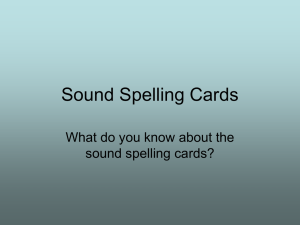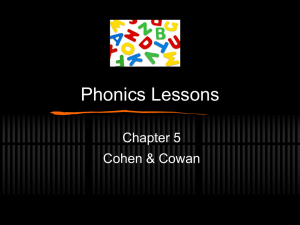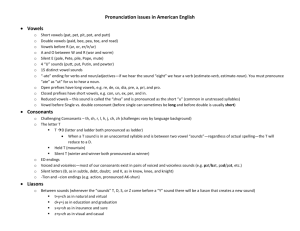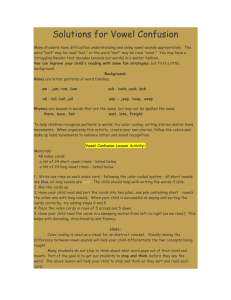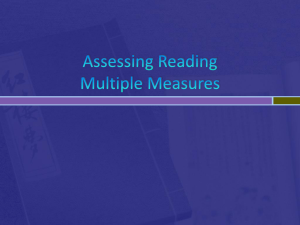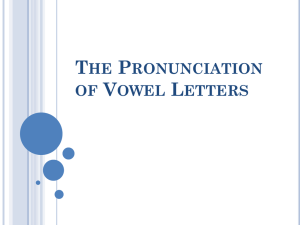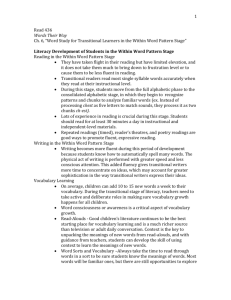Words Their Way-Ch6
advertisement
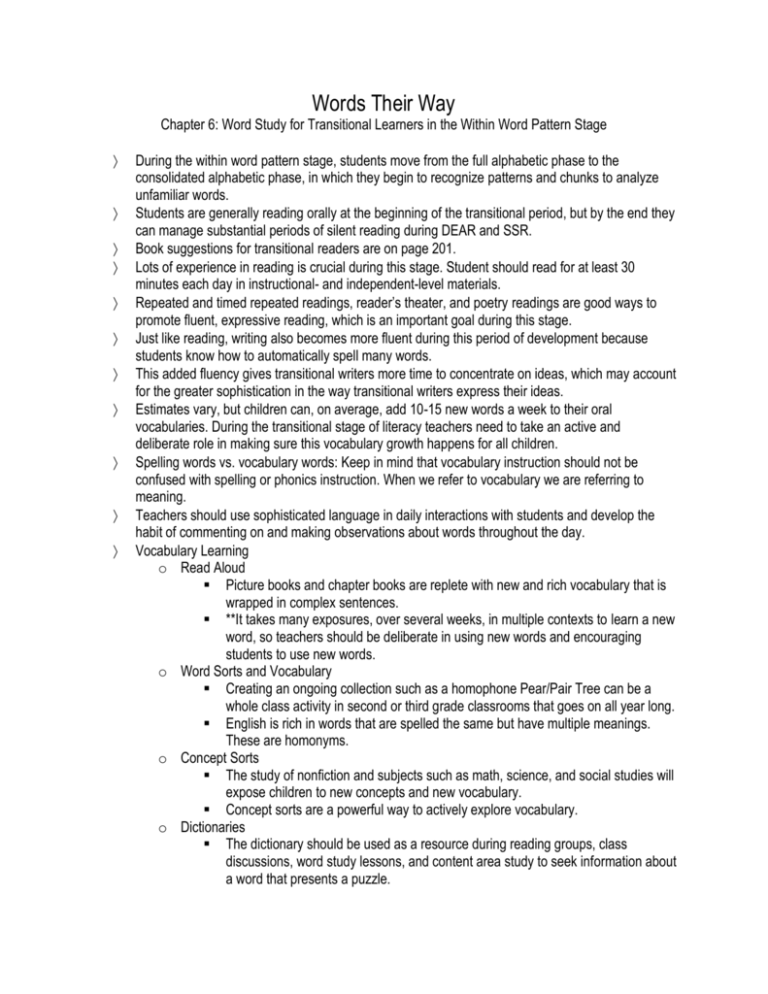
Words Their Way Chapter 6: Word Study for Transitional Learners in the Within Word Pattern Stage During the within word pattern stage, students move from the full alphabetic phase to the consolidated alphabetic phase, in which they begin to recognize patterns and chunks to analyze unfamiliar words. Students are generally reading orally at the beginning of the transitional period, but by the end they can manage substantial periods of silent reading during DEAR and SSR. Book suggestions for transitional readers are on page 201. Lots of experience in reading is crucial during this stage. Student should read for at least 30 minutes each day in instructional- and independent-level materials. Repeated and timed repeated readings, reader’s theater, and poetry readings are good ways to promote fluent, expressive reading, which is an important goal during this stage. Just like reading, writing also becomes more fluent during this period of development because students know how to automatically spell many words. This added fluency gives transitional writers more time to concentrate on ideas, which may account for the greater sophistication in the way transitional writers express their ideas. Estimates vary, but children can, on average, add 10-15 new words a week to their oral vocabularies. During the transitional stage of literacy teachers need to take an active and deliberate role in making sure this vocabulary growth happens for all children. Spelling words vs. vocabulary words: Keep in mind that vocabulary instruction should not be confused with spelling or phonics instruction. When we refer to vocabulary we are referring to meaning. Teachers should use sophisticated language in daily interactions with students and develop the habit of commenting on and making observations about words throughout the day. Vocabulary Learning o Read Aloud Picture books and chapter books are replete with new and rich vocabulary that is wrapped in complex sentences. **It takes many exposures, over several weeks, in multiple contexts to learn a new word, so teachers should be deliberate in using new words and encouraging students to use new words. o Word Sorts and Vocabulary Creating an ongoing collection such as a homophone Pear/Pair Tree can be a whole class activity in second or third grade classrooms that goes on all year long. English is rich in words that are spelled the same but have multiple meanings. These are homonyms. o Concept Sorts The study of nonfiction and subjects such as math, science, and social studies will expose children to new concepts and new vocabulary. Concept sorts are a powerful way to actively explore vocabulary. o Dictionaries The dictionary should be used as a resource during reading groups, class discussions, word study lessons, and content area study to seek information about a word that presents a puzzle. “How Many Turns?” game: Students are asked to find a word and whoever can find it in the fewest number of turns wins. o Simple prefixes and suffixes A systematic and extensive exploration of prefixes and suffixes occurs in the next stage—syllables and affixes. However, students can be taught simple affixes as meaning vocabulary beginning in second grade when most students are developmentally in the within word pattern stage of spelling. The most common prefixes in the English language are un-, re-, in-, and dis-. Several states mandate that the suffixes –ly, -ful, and –y and the comparatives – er/-est be taught in second grade. By the time students reach the within word pattern stage, their phonemic awareness is well developed. Short vowels, blends, and digraphs are nearly mastered and should only require some review. Students in this stage explore the pattern layer of English spelling. They must not only isolate the phonemes to determine the sounds they need to represent but must also choose from a variety of patterns that represent the same phoneme, which usually involve silent letters as part of the vowel spelling or special consonant patterns. There are several reasons why the same phoneme may be spelled with different patterns: o How words are spelled may depend on their histories and origins. o How sounds are spelled may depend on their positions within a word. o How sounds are spelled may depend on other sounds next to them. o How words are spelled may depend on the meaning of the word. The study of vowel patterns characterizes much of the word study during the within word pattern stage. Short vowels pose a problem for letter name-alphabetic spellers because they do not match a letter name. The mastery of other vowels is challenging due to the following factors: o There are many more vowel sounds than there are letters to represent them. o Not only are there more vowel sounds than vowels, most of those sounds are spelled a number of different ways. o In addition to short and long vowels, there are many more vowel sounds, all of which are spelled with a variety of patterns. o English is a language of multiple dialects, and the differences among dialects are very noticeable in the pronunciations of vowels. o Many words in English do not match even one of the patterns. o English vowels pose special challenges for English learners because English has so many more vowel sounds than most languages. In English, vowel patterns often consist of two vowels, one of which signals or marks a particular sound for the other vowel. The presence of an r following a vowel robs the sound from the vowel before it. The terms rinfluenced or r-controlled both refer to this situation. Consonant issues the pose a challenge for within word pattern spellers are three-letter blends and digraphs. Complex consonant patterns: students in the within word pattern stage can examine words that end in ck (kick), tch (catch), and dge (ledge). When g and c are followed by a, o, and u, they have a hard sound, as in gate and cake. When they are followed by I, e, or y, they have a soft sound, as in ginger or cent. Sound, pattern, and meaning are emphasized in the study of homophones, homographs, and many irregular verbs. Principles for word sorts: o Students should be able to read the words before sorting o Choose sorts that match the students’ development and represent what they use but confuse o Avoid teaching rules—instead, have students find reliable patterns. o Sort by sound and pattern. o Don’t hide exceptions. Format for word sorts: o Demonstrate the sort. o Sort and check. o Reflect: Declare, compare, and contrast. o Extend: Students work independently across the week. Students in the early part of the within word pattern stage who may still have problems distinguishing between spoken short and long vowel sounds benefit from a picture sort. Picture sorts develop phonemic awareness and focus attention on the sound without the support of the printed word. One basic procedure is a two-step sort that begins with sound and moves to pattern. Placements in the Within Word Pattern Stage: o Early: Students know blends and digraphs and spell most short vowels correctly. They are often experimenting with silent letters that mark long vowels. o Middle: Students are spelling the vowels with the CVCe patterns correctly but still making errors on the less common long vowel patterns as well as other vowels such as rinfluenced vowels and ambiguous vowels. o Students will have mastered the long vowel pattern but will be making a few errors in the other vowels—r-influenced and ambiguous. Because there is a lot to cover in this stage, two years is not too long to address the range of features for students of average achievement. Pacing will depend on several factors: o Developmental level o Grade level o Rate of progress For early within word pattern spellers in late first or early second grade, an introductory pace is recommended. To differentiate instruction at students’ developmental levels, you must monitor progress and adjust the lessons by adding extra sorts for students who need a slower pace or skip some sorts to increase the pace when possible. The following guidelines will help when planning the study of high-frequency words (use with a word wall): o Select 6-10 words for one week of each nine-week period for a total of 24-40 words a year. o Develop routines such as the following to help students examine and study the words carefully. Instruction and discussion Self-corrected test method Self-study method Practice test Final test By the end of the second grade, most students should be well into the middle of the within word pattern stage or beyond. There are several ways to monitor progress of students in the with word pattern stage” o Weekly spelling tests (use blind sort method when testing) o Unit assessments o Goal setting o Spell checks Knowing something about students’ native languages and writing systems is helpful so teachers can guide comparisons and understand the difficulties English learners face. Strategies for Teaching and Assessing English for English Learners are on Page 221. Differentiation occurs when students meet in small groups in which sorts are introduced and discussed under the guidance of the teacher. However, after than everyone can engage in the same weekly routines. Vocabulary instruction is usually not differentiated unless it involves words from the weekly sort or words that turn up in reading groups. Word study notebooks o The word study section is where students record their weekly sort and other activities. Students can be asked to summarize what they learned from their sorts in their own words. o The vocabulary section of the word study notebook is where students will record words from their reading or from content area instruction. o A third section might be an ongoing list of homophones, homographs, and polysemous (multiple meaning) words, with sentences or pictures to illustrate the different meanings of the words. To help students see the connection between word study and reading, ask them to go through what they have recently read to find words that fit the particular sound or pattern they are studying.
